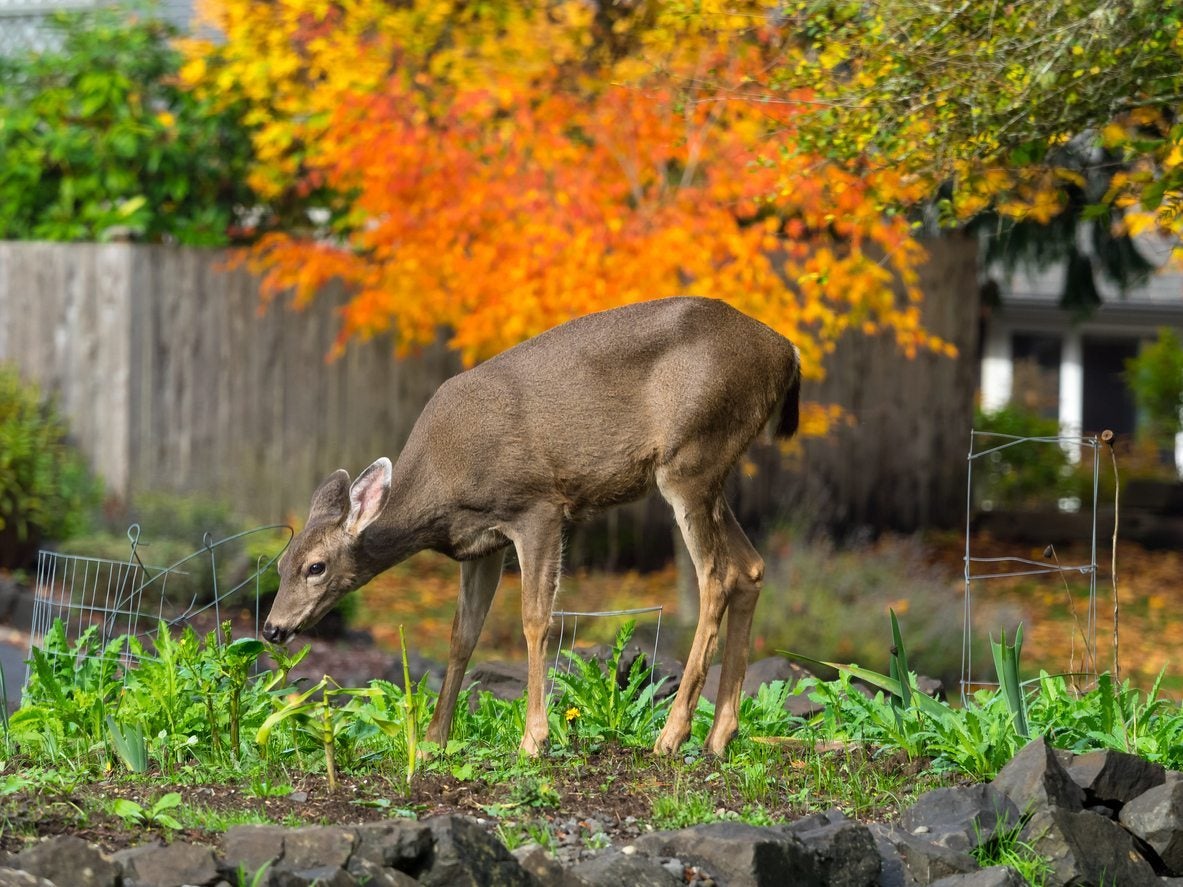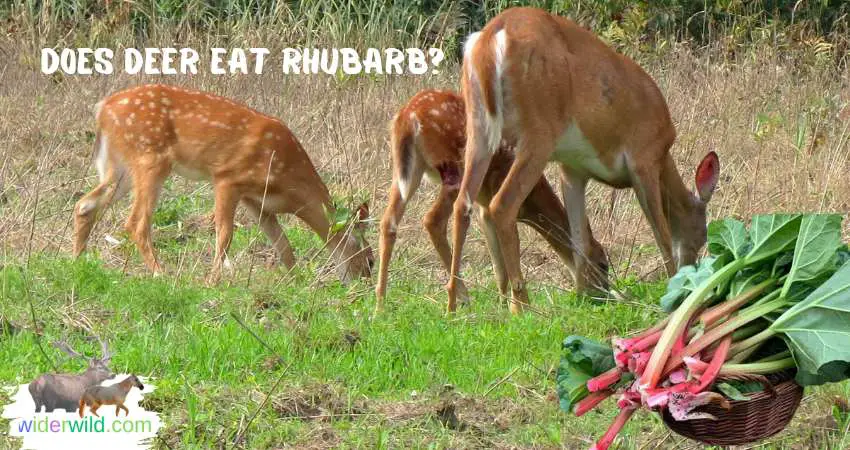Yes, deer eat rhubarb. Rhubarb is a favorite food for many deer species.
Rhubarb, a widely loved plant for its tangy taste and culinary uses, is unfortunately not safe from the appetite of deer.
With its succulent stems and leafy greens, rhubarb becomes an enticing treat for these animals, often leading to damaged crops and frustrated gardeners.
Despite the usual assumption that deer avoid plants with high oxalic acid content, they seem to have developed a taste for rhubarb despite its higher concentration of this compound.
This presents a challenge for gardeners and farmers who wish to protect their rhubarb crops from hungry deer. However, various strategies can be employed to deter these grazing animals and safeguard the precious rhubarb harvest.
Rhubarb And Deer: A Natural Connection

Are you wondering whether deer have a fondness for your precious rhubarb? Well, you’re not alone. Many gardeners find themselves facing the challenge of protecting their rhubarb plants from curious wildlife.
Rhubarb As A Popular Garden Plant
Rhubarb, with its vibrant red stalks and tart flavor, is a beloved garden plant. It’s commonly used in pies, jams, and various culinary delights. But did you know that rhubarb is also highly sought after by deer?
The lush green leaves and succulent stalks of this plant make it a tempting treat for these gentle grazers. However, it’s important to note that while deer may be attracted to rhubarb, they typically do not consume the plant in its entirety.
Deer’s Feeding Habits In The Wild
In the wild, deer have a diverse diet consisting of leaves, grass, shrubs, and other vegetation. They are known to be selective eaters, targeting plants that provide them with the necessary nutrients to thrive.
Deer primarily targets the leaves rather than the stalks. This is because rhubarb leaves contain oxalic acid, a compound that can be toxic to many animals, including deer.
It’s fascinating to observe how deer adapt their feeding habits based on their nutritional needs and the surrounding environment. These graceful creatures have a keen sense of what plants are safe to consume and what plants should be avoided.
While rhubarb may appeal to their senses, deer are cautious enough to avoid consuming large quantities of the plant, focusing instead on easily digestible parts such as grass and shrubs.
However, gardeners need to take measures to protect their rhubarb from excessive deer browsing, as prolonged nibbling can stress the plants and hinder their growth.
Deer Diet And Rhubarb

Deer are known to be selective herbivores, which means they have specific preferences when it comes to their diet. Their primary food sources include leaves, stems, fruits, nuts, and shoots.
However, their preferences may vary depending on the availability of food in their habitat and the time of year. Knowing what deer typically eat can help us determine if rhubarb is a likely part of their diet or not.
Although rhubarb is not typically a preferred food for deer, there are some potential reasons why they might still consume it:
Scarcity of preferred food sources: When their primary food sources become scarce, deer may turn to alternative options, including rhubarb. This especially holds true during periods of food scarcity such as winter when their usual food sources are limited.
Seedling stage attraction: Rhubarb plants, especially in their early seedling stage, may be tempting for deer due to their tender and nutrient-rich shoots. The young leaves and stems can be appealing to deer searching for easily accessible food.
Limited food sources in urban areas: In regions where deer coexist with human settlements, their diet choices may expand to include non-typical food sources such as ornamental plants and garden crops like rhubarb.
Urban environments often lack natural forage options for deer, forcing them to adapt and include unconventional food sources.
While deer may occasionally nibble on rhubarb, it is important to note that they typically do not rely on it as a significant part of their diet. If you are a gardener concerned about deer damage, it’s advisable to take appropriate measures to protect your rhubarb plants and ensure the deer have access to more suitable forage elsewhere.
The Impact Of Deer On Rhubarb Plants
The Damage Caused By Deer Feeding On Rhubarb
Rhubarb plants are known for their robust nature and tart stalks that are commonly used in cooking and baking. However, these plants can become a target for hungry deer, leading to potential damage and frustration for gardeners. Deer are voracious eaters and can wreak havoc on rhubarb plants if left unchecked.
When deer feed on rhubarb, they can cause several types of damage. The most obvious is the loss of foliage, as deer graze on the leaves and stems of the plant. This deprives the rhubarb of crucial nutrients and can weaken it, making it more susceptible to disease and other pests.
In addition to foliage damage, deer may also nibble on the rhubarb stalks themselves. This not only reduces the harvestable portion of the plant but can also introduce contaminants or organisms that may affect the quality of the stalks.
Furthermore, deer are known to trample and compact the soil around rhubarb plants while grazing. This can disrupt the delicate root system and hinder the plant’s ability to uptake water and nutrients effectively.
Identifying Signs Of Deer Presence In The Garden
It’s crucial to be able to identify signs of deer presence in your garden to take appropriate action to protect your rhubarb plants. Here are some common signs:
- Deer tracks: Look for hoof prints in the soil or mud that indicate the presence of deer.
- Browsed foliage: Check for partially eaten leaves and stems, especially those with a ragged or torn appearance.
- Trampled vegetation: Deer may leave a trail of crushed plants or flattened areas where they have walked or rested.
- Deer droppings: Deer droppings are typically small, round pellets and can be found near areas where they have been feeding.
If you observe any of these signs, it’s essential to take immediate action to protect your rhubarb plants. There are various strategies you can employ, such as installing fencing or using deer repellents, to deter deer from feasting on your precious rhubarb.
Effective Strategies To Protect Rhubarb From Deer
Deer can be a nuisance for gardeners, especially when they find their way to your beloved rhubarb patch. If you’ve ever wondered, “Does deer eat rhubarb?” the answer is, unfortunately, yes.
To safeguard your rhubarb from these hungry visitors, it’s essential to implement effective strategies that keep them at bay.
Natural Deterrents For Keeping Deer Away From Rhubarb
When it comes to deterring deer from indulging in your rhubarb, implementing natural options is often an eco-friendly and cost-effective approach. Here are some natural deterrents you can consider:
Plant Deer-Resistant Companion Plants: Surrounding your rhubarb with plants that deer find unappealing can act as a natural deterrent. Some examples include foxgloves, lavender, and marigolds.
Use Strong-Scented Repellents: Deer are highly sensitive to strong smells. Consider incorporating strong-scented repellents, such as garlic or vinegar-based sprays, around your rhubarb patch to discourage their presence.
Install Motion-Activated Sprinklers: Motion-activated sprinklers can be an effective way to startle and deter deer. These devices are triggered by movement and release a sudden burst of water, scaring away any nearby deer.
Hang Shiny Objects: Deer are naturally skittish animals and can be deterred by shiny objects. Hanging aluminum foil strips or CDs around your rhubarb, creating flashes of light, can help keep them at a distance.
Create Noise Disturbances: Deer prefer quiet and peaceful environments. By introducing noise disturbances, such as wind chimes or even a radio set to a talk show, you can discourage them from approaching your rhubarb patch.
Installing Physical Barriers As A Preventive Measure
If natural deterrents fail to keep deer away, installing physical barriers can be an effective preventive measure to protect your rhubarb.
Here are some options you can consider:
Fencing: A sturdy fence around your rhubarb patch can act as a reliable deterrent. Opt for a height of at least 8 feet, as deer are excellent jumpers.
Netting: Netting can be a practical solution to physically separate deer from your rhubarb. Ensure it is constructed using strong and durable materials to withstand any attempts at nibbling.
Covered Cages: Constructing sturdy cages using wire mesh or wooden frames can provide a protective enclosure for your rhubarb. Make sure to cover the top as well to prevent deer from reaching down.
Remember, when it comes to protecting your rhubarb from deer, a combination of natural deterrents and physical barriers can effectively discourage these unwelcome visitors.
Experiment with different strategies to find the best approach that suits your specific situation and ensures the safety of your rhubarb year after year.

Credit: www.gardeningknowhow.com
Frequently Asked Questions On Does Deer Eat Rhubarb?
Do Deer Eat Rhubarb Leaves?
Yes, deer are known to eat rhubarb leaves due to their sweet and tender nature.
Are Rhubarb Stalks Safe For Deer To Consume?
No, rhubarb stalks are toxic for deer to consume as they contain high levels of oxalic acid.
Can Deer Destroy A Rhubarb Plant?
Yes, deer can cause significant damage to a rhubarb plant by eating its leaves and trampling its stalks.
How Can I Protect My Rhubarb From Deer?
To protect your rhubarb from deer, consider using fencing, installing motion-activated sprinklers, or applying deer deterrents.
What Other Plants Do Deer Prefer Over Rhubarb?
Deer prefer to graze on plants such as hostas, roses, and daylilies, which are more appealing to them than rhubarb.
Are There Any Deer-resistant Varieties Of Rhubarb?
While no rhubarb varieties are completely deer-resistant, some varieties like Victoria and Crimson Cherry are less appealing to deer.
What Attracts Deer To Rhubarb In The First Place?
Deer are attracted to rhubarb due to its succulent leaves and the lack of natural deterrents, making it an attractive snack for them.
Forum Discussion about it
“Deer do eat rhubarb leaves and stalks, as confirmed by the experiences of individuals living in Colorado and central New Jersey. In Colorado, large bite marks were observed on larger stalks, and many smaller stalks were eaten through.
Similarly, in central New Jersey, deer were reported to have finished off eight large rhubarb plants, consuming them right down to the stalk. Additionally, a user on the IdigMyGarden site mentioned that mule deer specifically eat rhubarb.
The toxicity of rhubarb leaves was mentioned in a comment, expressing a hope that deer consuming them would be affected by the toxic chemicals.”
Conclusion
Deer, being opportunistic eaters, pose a challenge for gardeners as they may devour a variety of plants. Rhubarb, although not a preferred choice due to its toxicity, is not entirely immune to deer feeding, especially in areas with scarce food.
The oxalic acid-rich leaves deter deer, but hungry ones may still target the less toxic stalks.
To safeguard rhubarb, protective measures are essential. Fencing proves effective, creating a solid barrier against deer. Repellents, either homemade or store-bought, offer additional protection, but they require frequent reapplication.
Companion planting with deer-resistant species and scare strategies, like motion-activated sprinklers or lights, enhance defense against deer intrusion.

